Weird Harvest — The Truth is Out There...
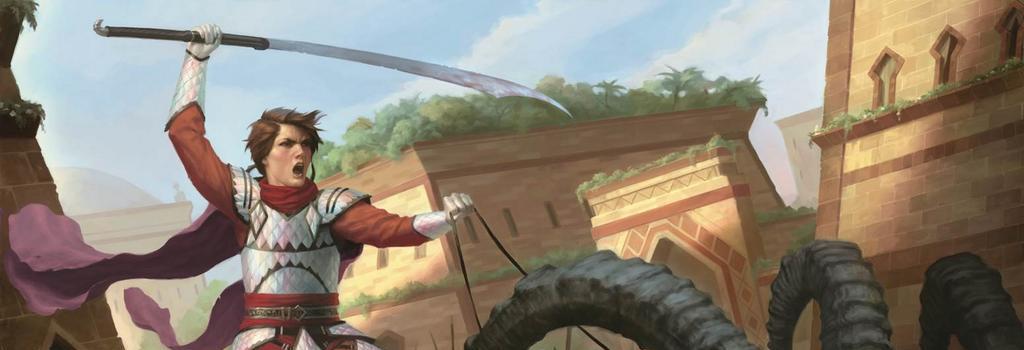
There’s something to be said about the unexpected. Since our format is predominantly multiplayer, it has the potential to yield some hilarious results. There’s also something janky about the idea of setting our opponents up to expect one thing and then hit them with another. I recently caught up on a bunch of episodes of Game Knights and noticed that Josh Lee Kwai talked about “Secret Commanders” in more than a couple of episodes. He even played his Cromat/Nekusar deck in at least one of the episodes I saw. The concept was something that I’ve never been exposed to, yet janky enough to spark my imagination. Sure, using a smokescreen commander to broaden your color identity could be beneficial for several strategies. That’s not exactly what I thought about, however, as I thought that it could be effective in hiding a lot more than a strategy or a commander. Put on your shady trench coats and prepare to dive into the seedy underbelly of EDH. We’re going undercover.

What can I say about this card that doesn’t sound like I’m overselling it? Her CMC is extremely efficient at 3. Her color identity is arguably among the best in the format for answers and removal. We are way ahead of curve getting a 4/4 body for only 3. She permanently buffs creatures when she attacks, which can happen early on given how grounded the deck is. Oh, and we also have a creature-specific Leyline of the Void effect stapled on for good measure. We could build this in many obvious ways, +1/+1 counters being perhaps the most obvious. That doesn’t give us a whole lot in the way of secrecy, so if we are going to use Anafenza as a smokescreen we’ll have to get creative.
Whatever happened to playing a hunch?
One of the biggest benefits of being in Abzan colors is that we have access to all the toolbox staples. If you’re unfamiliar with the concept, essentially we get a cast of creatures that have flexible and relevant abilities on them. This becomes extremely advantageous when leveraged with some form of recursion or tutoring, if not both. It just so happens that Abzan has some of the best options for both of those strategies as well. This means that we could run one or more secret commanders that directly abuse this. Let’s look at a few.

Karador, Ghost Chieftain: The grizzled veteran of recursion commanders, this ghost has proven to be among the best options available for emptying the crypts for value. His CMC can be prohibitive from time to time, which means that he isn’t a bad option for being ran in the 99. It seems that 401 decks have already taken to this idea, and I think we should join them.
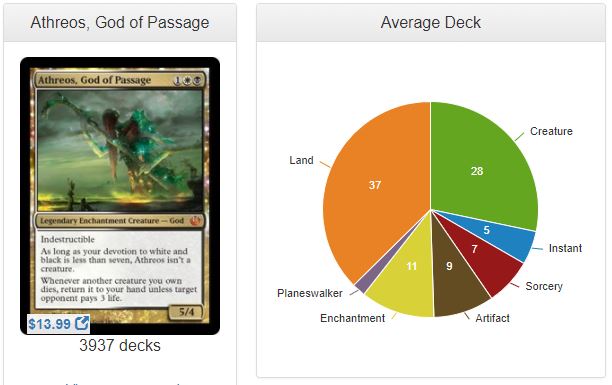
Athreos, God of Passage: An efficient, evasive, and persistent form or recursion in a 3 CMC package. This is an amazing backup to Karador, even if it doesn’t always get the creature back. Normally I tend to avoid cards that hinge too much upon our opponent’s making an unwise decision, but this one is too good to pass up. There are 3,937 decks that run it, and I think it’s obvious why.
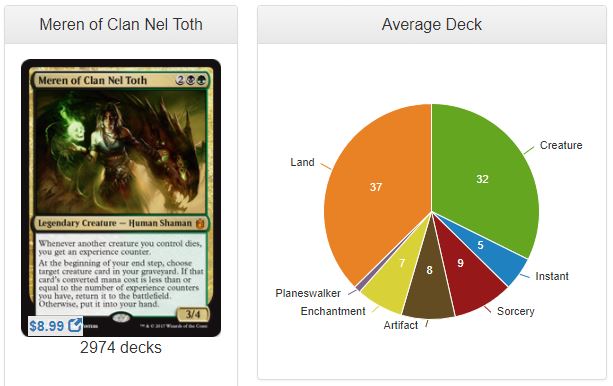
Meren of Clan Nel Toth: In the few short years since her printing she’s easily cemented herself as a recursion oriented all-star. Running her will be a fitting finish in a triple threat package of secret commanders to surprise our opponents with. There are 2,974 decks that run her, and it’s probably for the same reasons that decks run Athreos, God of Passage.
The element of surprise, random acts of unpredictability?
As novel as the idea of running secret commanders is, it's a wasted concept if we don’t build it into a deck that can stand just fine without our hidden celebrity. I don’t personally think secret commanders is a very good strategy when it’s “all in” for several reasons, with lack of resiliency to disruption being among the top. That’s one of the key benefits of running such a decent amount of recursion is that we are essentially providing ourselves with redundancy to get our secret commanders back provided they don’t get exiled. While we may not be re-inventing the wheel with our toolbox creatures, we can certainly get creative with a few of our card choices to make full use of our primary commander.
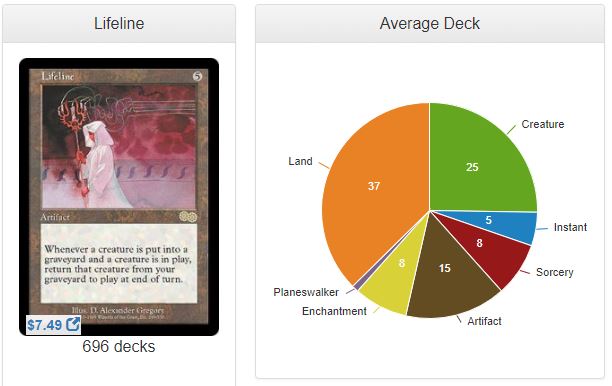
Lifeline: This is perhaps the silliest card of all to run with our primary commander. With Anafenza out, we ensure that our opponents creatures never hit the yard. The second ability functions as a replacement effect, and as such makes this card one-sided. Even if our opponents manage to keep Anafenza off the table, we are more suited to make use of the card than they are a majority of the time. There are 696 decks using it now, and I suspect the number will increase over the next few years as we continue to see value oriented creatures get printed.
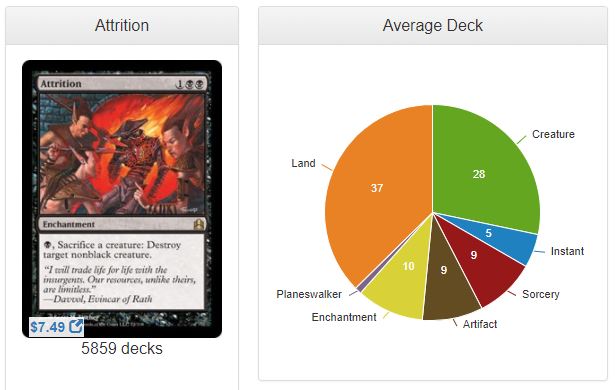
Attrition: Perhaps one of the best enchantments that black has to offer the format, this card gets especially awesome when Anafenza is out. It essentially reads, “B: Sacrifice a creature, exile target non-black creature.” With the amount of recursion that we are running, this is a no brainer for the removal package. Not to mention it’s a sacrifice enabler, which is a nice bonus. There are 5,859 decks that run it, because it’s just that good.

Cataclysmic Gearhulk: It’s worth noting that this card is particularly fun when it’s recursive and tilted in your favor. If we manage to get Lifeline on the board, this should certainly be on our hit list of cards to resolve since it is essentially one-sided at that point. It sees play in 1,767 decks currently and I have a feeling that it will slowly trend upwards in white-centric graveyard decks as time goes on. On its worst day it’s a partial board wipe for 5 CMC on a respectable body with a relevant combat ability.
...And it hurts.
It’s important to note at this point that the options for this deck, both for the toolbox and for the secret commanders, are broad and full of variety. There are many ways this concept could be approached and that was perhaps the hardest thing to overcome when constructing this deck. At one point there was a desire for me to use Glissa, the Traitor as a secret commander and put a keen focus on sacrificing/recurring artifacts. The color identity and the toolbox strategy both lend themselves to a fair bit of interesting tech that have the potential to be a blast to play. The hardest thing overall was to avoid building a bad “insert secret commander here” deck. The potential to just build a bad Meren of Clan Nel Toth deck was high. At times I had to catch myself trying to auto-include cards that would make sense for that deck without thinking about the slot that it was competing for. This made it a delicate task to balance the spread of colors, effects, and casting costs when creating the toolbox. This is what resulted in quite a few creatures, and likely ones that you consider to be glaring omissions, not making the cut. In the end, this is what I came up with.
[Creatures] *1 Viscera Seer *1 Ayli, Eternal Pilgrim *1 Sakura-Tribe Elder *1 Viridian Emissary *1 Athreos, God of Passage *1 Eternal Witness *1 Fiend Hunter *1 Grim Haruspex *1 Yisan, the Wanderer Bard *1 Gonti, Lord of Luxury *1 Meren of Clan Nel Toth *1 Smothering Abomination *1 Solemn Simulacrum *1 Acidic Slime *1 Cataclysmic Gearhulk *1 Gray Merchant of Asphodel *1 Karmic Guide *1 Bane of Progress *1 Duplicant *1 Patron of the Vein *1 Steel Hellkite *1 Sun Titan *1 Wurmcoil Engine *1 Avenger of Zendikar *1 Elesh Norn, Grand Cenobite *1 Sheoldred, Whispering One *1 Karador, Ghost Chieftain [/Creatures]
[Artifacts] *1 Sol Ring *1 Golgari Signet *1 Orzhov Signet *1 Selesnya Signet *1 Ashnod's Altar *1 Chromatic Lantern *1 Phyrexian Altar *1 Birthing Pod *1 Whip of Erebos *1 Lifeline [/Artifacts]
[Enchantments] *1 Land Tax *1 Phyrexian Reclamation *1 Vampiric Rites *1 Sylvan Library *1 Attrition *1 Aura Shards [/Enchantments]
[Instants] *1 Enlightened Tutor *1 Path to Exile *1 Swords to Plowshares *1 Vampiric Tutor *1 Altar's Reap *1 Costly Plunder *1 Anguished Unmaking *1 Krosan Grip [/Instants]
[Sorceries] *1 Demonic Tutor *1 Diabolic Intent *1 Exsanguinate *1 Torment of Hailfire *1 Maelstrom Pulse *1 Primal Growth *1 Debt to the Deathless *1 Living Death [/Sorceries]
[Lands] *1 City of Brass *1 Command Tower *1 Evolving Wilds *7 Forest *1 Godless Shrine *1 Mana Confluence *1 Marsh Flats *1 Opal Palace *1 Overgrown Tomb *7 Plains *1 Reflecting Pool *1 Reliquary Tower *1 Sandsteppe Citadel *8 Swamp *1 Temple Garden *1 Temple of the False God *1 Terramorphic Expanse *1 Urborg, Tomb of Yawgmoth *1 Vault of the Archangel *1 Verdant Catacombs *1 Windswept Heath [/Lands]
[/Deck]
Overall, I feel that this strategy has some merit, but the competitiveness of it is without dispute. I don’t believe it is viable outside of relatively casual groups or meta. Aside from that I think it is an excellent exercise in exploring how to strengthen your skills in building with synergy and redundancy. I’m certain that this type of deckbuilding won’t ever appeal to the majority, which is fine and completely understandable. However, if you’re the adventurous type who enjoys a challenge and looks at the art of deckbuilding more as a puzzle than a process then you may have found your next archetype. I am excited to see what ideas all of you have for secret commanders and what archetypes you would build them into. I hope you enjoyed the article.
Until next time, keep on tapping in the free world.
EDHREC Code of Conduct